
|
||||||||
|
|
|
|
|
|
|
|
|
|
|
|
|
|
|
|||||

|
||||||||
|
|
|
|
|
|
|
|
|
|
|
|
|
|
|
|||||
|
|
| Old 3D Artwork |
This may be interesting if you are trying to get into the industry, as you can compare my current work, to some of this really old stuff, and perhaps that to what you yourself are doing now.
Some of it was created on an Amiga 3000 with Impulse's Imagine 3D software. At that time I think I had a 100 meg IDE drive, with 18 megs of Ram (16 basic, 2 video) and mostly worked at 320x240 with 4096 colors. Later I bought a Firecracker24 board, and worked at higher res's like 1024x768 with True 24 bit color for still images.
I used Imagine from version 1.0 all the way through 3.1 or so, when I had switched over to the PC version of the software, and off of my Amiga. Shortly after that, I started using Lightwave 3D 4 when it came out for the PC. This is about the time of the Seaquest DSV shows, and Babylon 5. A lot of the stuff from that inspired me. I pretty much used Lightwave 4 for a while, and then eventually got a job at Volition.
See my About Me Pagefor more info on how I got started in the industry and involved in CG.
Note that most of these images are digital photos based off of old printouts I had, so the quailty/color depth is kind of poor, and most are a bit noisy. I may get some better versions of them if I can find them, and if so will update this page.
So without further ado, here is the artwork...
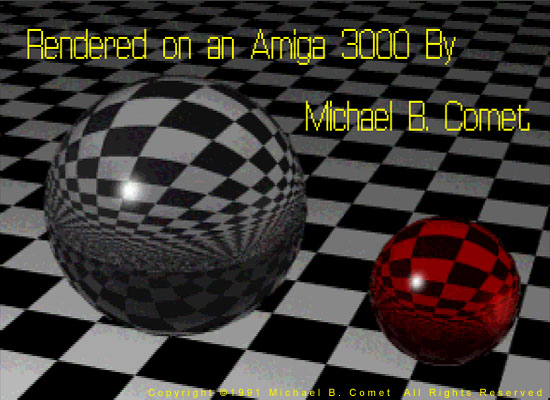 Chrome Spheres:
Chrome Spheres:
Well, what old original late 80's, early 90's art gallery would be correct if it didn't start with some form of chrome spheres on a checkerboard floor?
I remember thinking it was pretty cool to be able to get reflections, shadows and refractions all by 3D software... Though the shadows here are mysteriously absent, probably because it would have taken too long to Ray Trace.
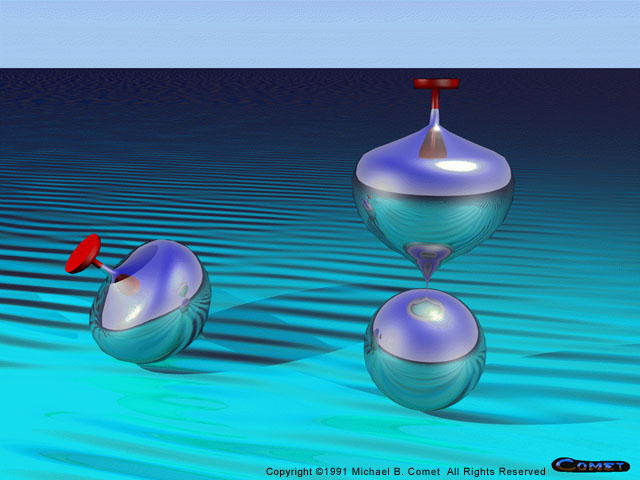 Tops1:
Tops1:
This is a pretty old Image. Done using Imagine...probably from 1991-1993 sometime...I'm not exactly sure. It was the good old days with chrome and ray tracing. Though at least I was smart enough not to use a checkered ground..hehe.
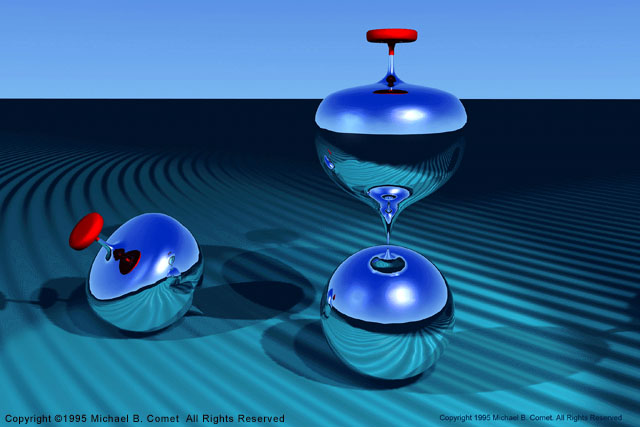 Tops2:
Tops2:
I actually liked the colors and composition of the original image so much, I redid it with Imagine later on. I'm not sure if this was one of my last Imagine versions, or if I had switched to Lightwave by this point, though I think it was still Imagine r3.
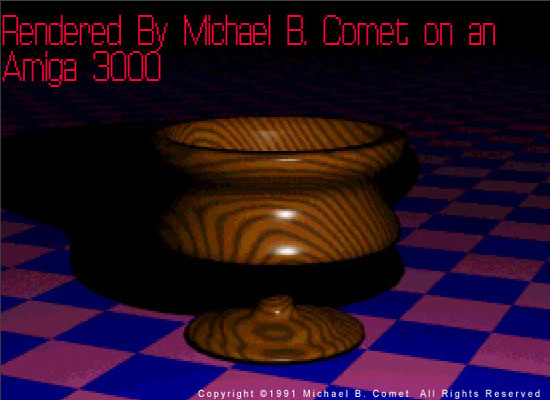 Wood Bowl 1:
Wood Bowl 1:
Wow, I can lathe! Amazing modeling! That with a nice ugly checkerboard floor, and built in procedural wood textures, this all made me a pretty basic beginning 3D artist at this stage.
I guess I was quite proud of having an Amiga back then, as I tacked that text onto the image after it was rendered.
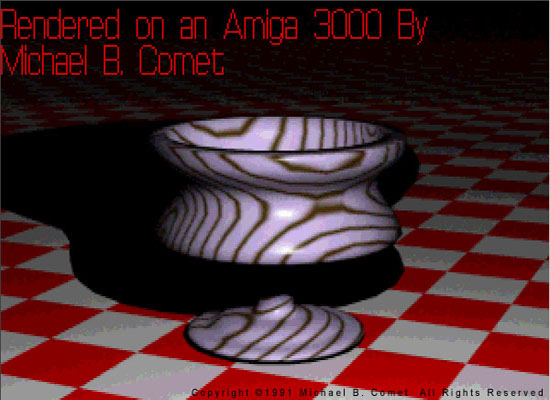 Wood Bowl 2:
Wood Bowl 2:
This is the cool "Zebra" variation of the original model. At this point in 1991, I was basically trying to still understand "3D" and the software in general, and learn the tools, and how to create models, and lights etc... I figure I finally felt like I "knew" all the tools in the program about a year or so after I started, which would be late 1991 or early 1992. After that I reread the manuals, played around for another year, at which point, I was finally able to start developing some techniques based on the basic tools I truly grasped, which would have been some of the better lighting, modeling and texturing you see later in 1993-1994. After that point, it was pretty much just improving artstically, learning new tools and new techniques.
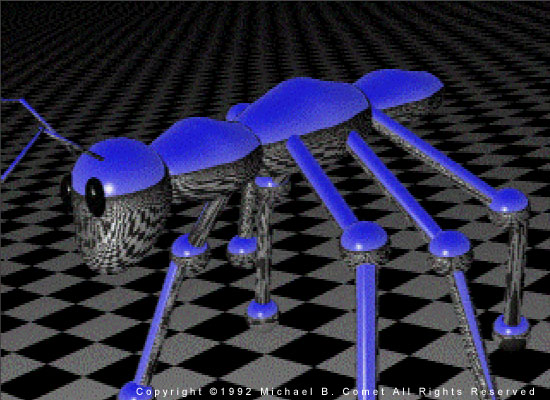 ChromeAnt:
ChromeAnt:
This was actually a fairly early image I did back in the early days. I remember working on it in my parents family room, while my Dad did video editing with his Video Toaster. Created around 1992, maybe a little earlier. I just stuck a few basic objects together, set the sky and ground, and set it to ray trace...
Yes, it has the old and of course bad checkerboard ground, but at least it's not just a plain chrome sphere!
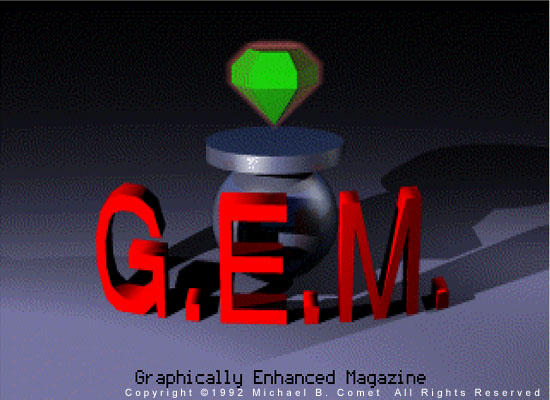 GEM Title Screen:
GEM Title Screen:
This was a title screen for a magazine my brother Ari and I worked on called the "Graphically Enhanced Magazine". At that time I was doing a lot of C and Pascal programming in my free time. I wrote my own 2D paint program similar to Deluxe Paint. I used that and my graphics programming knowledge to write a text based magazine with custom menus and such, that also had basic VGA graphics in it.
This was the startup screen when this issue of the "magazine" came out in 1992.
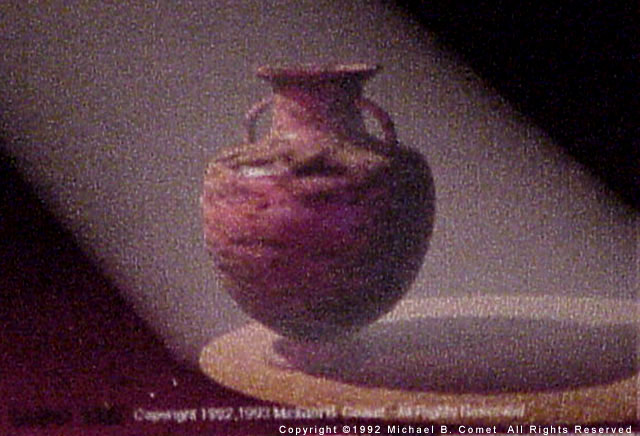 Vase:
Vase:
This was a really simple lathed object with bent cylinders for the arms inspired by a Lightwave model. I textured it with a rock map, but then started playing with colored lighting. This was kind of the beginning of me really starting to learn about basic 3 point lighting, warm and cool colors etc... I studied a lot of the basic television studio logos on TV to figure what made their lighting so cool, which then later helped me in my own work.
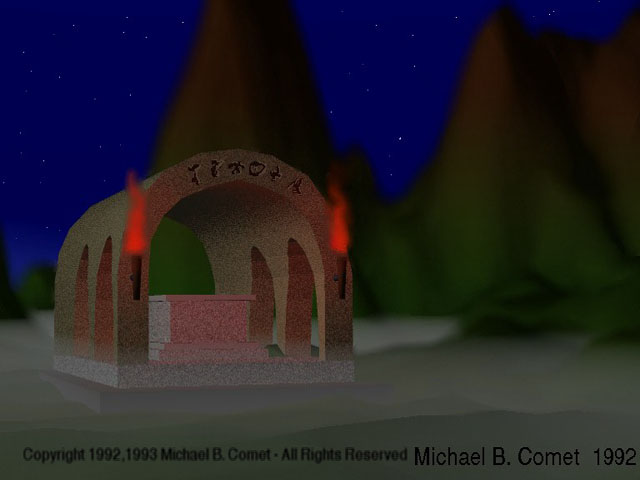 shrine:
shrine:
This is an old Imagine 2.0 render. I found the readme file for it, and here is what it says: Shrine.jpg is an image of a fantasy shrine set in a valley. The image was rendered entirely in Imagine and touched up in Light 24.
Background mountains were imported using VistaPro 1.0's save as Turbo Silver object function. They were then rescaled and editied. Then I used a linear texture on them for the green-to-brown.
The temple is a simple object made by slicing several parts. The stone texture is simple a "roughness" setting on the object. The fog on the bottom was made using Imagine 2.0's global fog feature.
The fire was hand draw in Light 24 as are the fake letters on the
front of the temple. To make the coloring correct however, low intesity
RED lights were placed at the proper torch locations for the render so the
ground below and stone behind had the proper color.
The background sky and mountain bluring were also hand drawn. All done in 1992.
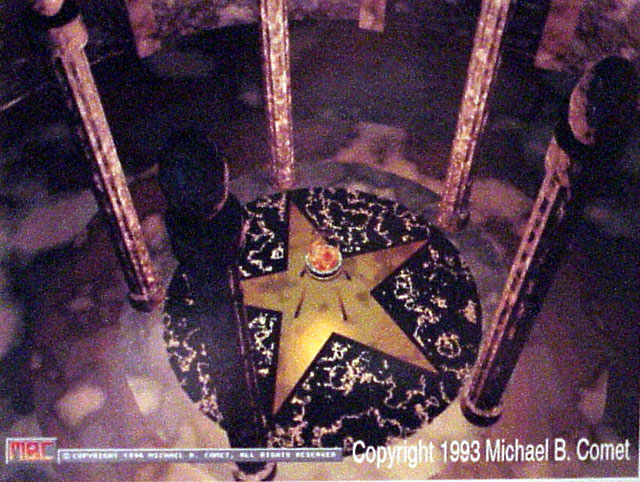 Temple 2:
Temple 2:
This is a really simple image I did with Imagine. Pretty much basic shapes twisted or edited for this animation I did. It was a good test of basic software modeling knowledge, and for playing with lighting. I actually used this scene as a test when I switched over to Lightwave, and then MAX to see if I could recreate it in those packages. Created around 1992-1993.
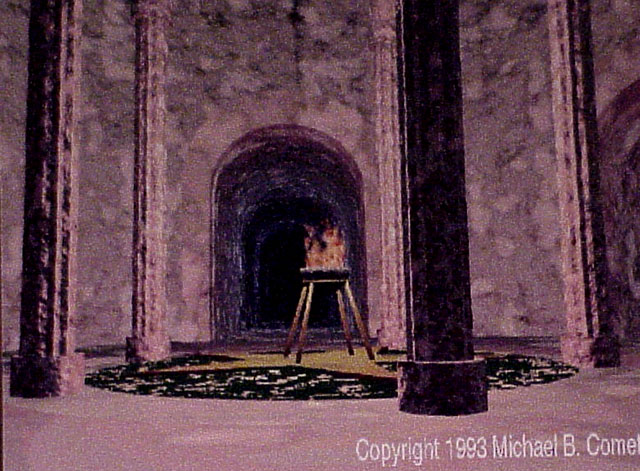 Temple 2:
Temple 2:
This is another angle of the temp animation I did. The fire was created by a simple cylinder object mapped with some fractal noise for transparency and color.
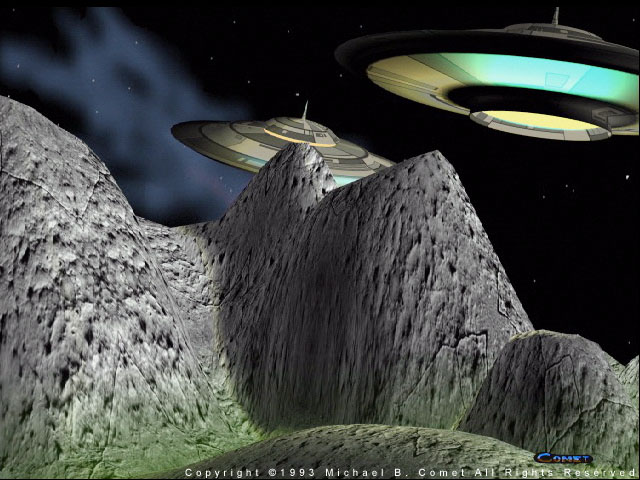 Forest:
Forest:
I'm not sure why I always called this image "forest". I think I wanted to have trees but then realized how hard it would have been back then. This is from around 1992 or 1993.
This image was submitted to the Imagine Mailing List contest, where it took first place in the HAM (4096 color) category. This image is a re-render in 24 bit mode. The background sky is a drawing I did with Light24 program and Firecracker24 board. The mountatin texture was a digitized rock repeated and mapped from above, then falling off by using a ramp/linear texture for the green at the bottom. Also the space ships were a mapped with a hand drawn texture.
A lot of people really liked the image, and animation I had of the ships flying over, even though I thought it was really basic and plain.
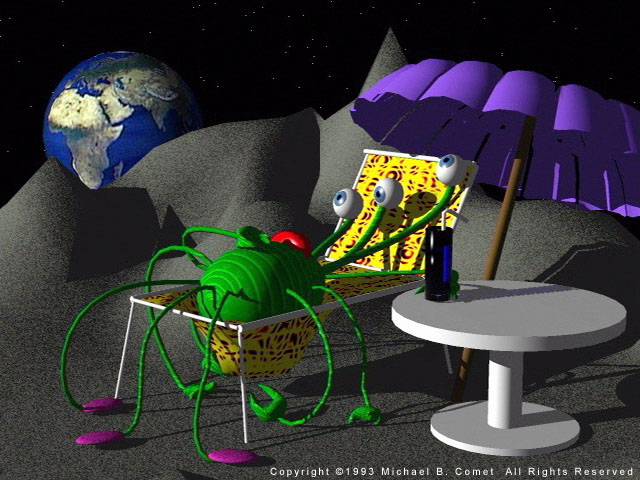 Alien Vacation:
Alien Vacation:
This and the Bathroom image below took 2nd place for an Imagine Mailing List contest way back in 1992 or 1993 or so.
Most of the objects are obviously pretty simple, sphere for the alien, with cylinders bent into shape. And deformed planes for most of the rest of the parts.
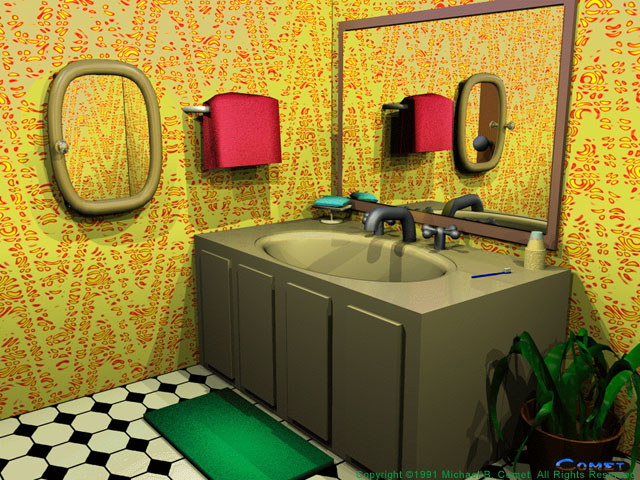 Bathroom:
Bathroom:
This done with Imagine 2.0 on my Amiga 3000. This, my Alien Vacation, and some one elses entry all had a 3 way tie for 2nd place in the Imagine Mailing List Contest. Most of my work at this time used basic modeling from primitives, and learning good lighting and basic texturing.
I had like 10-20 lights probably to get the effect, most Ray Traced since that was the only way to get shadows. You can see some of the duplicate lights by looking at the shadows around the faucet on the sink. I added them to help illuminate the mirror correctly. And yes, that wallpaper IS really ugly!
Notice too, most of the objects are really pretty basic...Extruded shapes for the leaves, a lathed shape for the cups, cylinders bent for the faucet, and spheres for the knobs on the faucet, etc. Everything made by extruding, or deforming simple objects, since my modeling then wasn't too good, and the software required you to edit polygons point by point to really get anything detailed or organic.
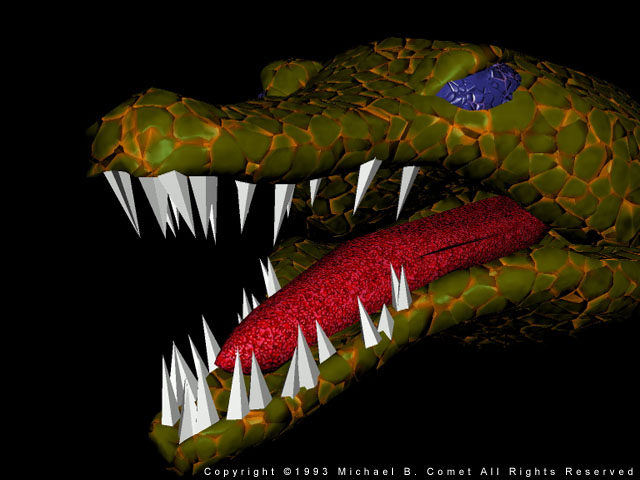 Dragon Head:
Dragon Head:
This is one of the few actual "characters" I did back in the old Imagine 2.0 days. Created with Imagines "Form Editor", which basically was just "lofting, or skinning". This means you lay out a spline outline, and it takes the cross sections and creates the form from the cross sections.
It was textured with Steve Worleys "Essence Textures II", which were, and probably
still are some of the best 3D procedural textures you can use. It basically had a lot of different stone, or noise type textures that you could setup and use.
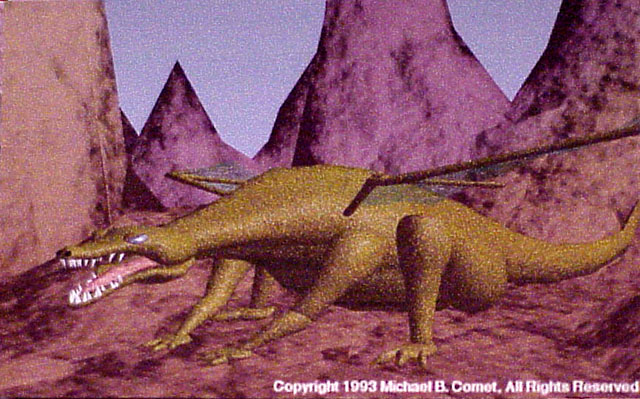 Dragon Head:
Dragon Head:
This shows the full body of the character, obviously just simple shapes parented to each other. I actually had an animation I did with this where the wings basically rotated through the body, and it landed. Indeed it was pretty poor animation. The wings literally just rotated back and forth with no smoothness.
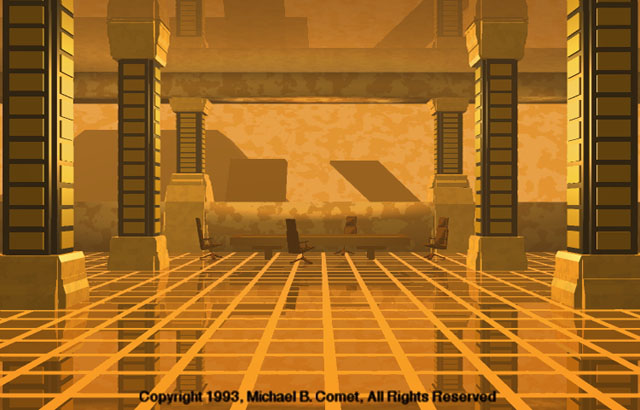 Blade Runner:
Blade Runner:
This is actually one of my favorite Ray Traces... Though of course I can't take full credit. Not only is the image based off of the movie, but mine was actually a copy of another 3D artists rendering. At that time, I was also interested in Lightwave, though I didn't have a copy...but I still picked up LW magazine. They usually had a gallery of 3D art stuff in the back. What I did was, I used that as a way to learn how to make my own stuff look good. I would basically study the image, figure out how to model and texture and light it, to see if I could do something as good.
So this is the result of that study. Obviously pretty simple deformed box objects mostly. The main thing was just setting the materials, reflectivity and lights. Not too bad for me in 1993.
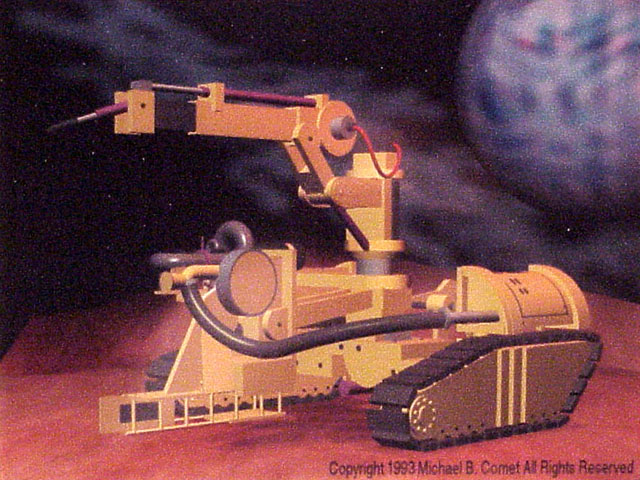 Cable Truck:
Cable Truck:
This was another "study" image based off of a model from another 3D artist featured in the old LW magazine...someone who eventually was working at Will Vinton, though I forgot his name. The purpose of this again was because when I saw his image I was like "Wow! Can I do that?". So I looked at it and broke it down, and tried. His was probably a little bit nicer, but this still came out pretty good for me. The background was my own. The planetscape was actually a model from the old old old Vistapro software I used on my Amiga, and was part of their Mars terrain data. The background nebula was a hand painted map, I think I did in my "Light24" which was the 24 bit paint program for my old Firecracker24 board.
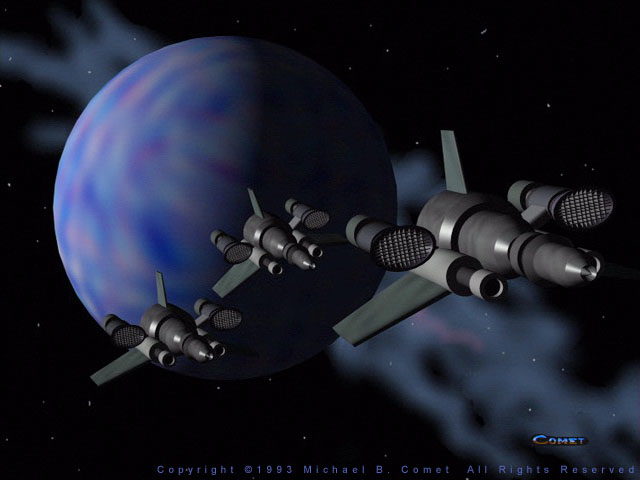 Space Fighter:
Space Fighter:
Inspired around 1993 by Babylon 5 and some of the Lightwave work by 3D artists at that time, I tried creating some of my own spaceships. My modeling skills were still pretty bad, as were some of my texturing ability, so this is what I did.
I didn't even use any Lens Flares. Actually, when I did use Lens Flares in Imagine, I did so by using an image map with transparency, since Imagine didn't have lens flares until a while after Lightwave originally added them.
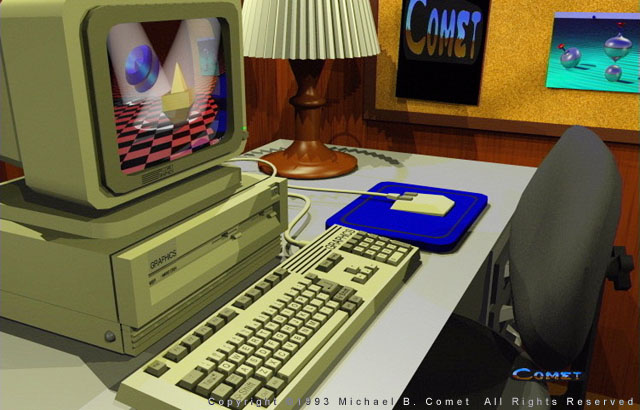 Computer Close:
Computer Close:
This was a rendering and model I did of my old Amiga 3000. This was created on the Amiga back in probably 1992 or 1993. I mapped each key with a separate letter imagemap, which at that time seemed pretty cool, and intensive.
Notice too the images mapped onto the screen and back tack wall. Once again the objects are still pretty simple, deformed spheres, lathed shapes, boxes, and a few things done by using Booleans. Notice too the mouse is actually supposed to be higher and was intersecting the mousepad actually...
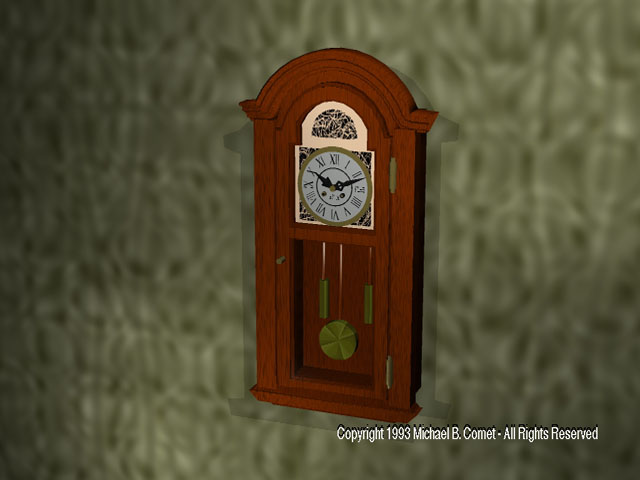 Chime Clock:
Chime Clock:
Here once again I was practicing by looking at a picture of a real object, and trying to
see if I could model it. I was getting a bit better with understanding the modeling tools,
and texturing, and how to get them to do what I wanted, and how to break down objects so they
could be built in 3D.
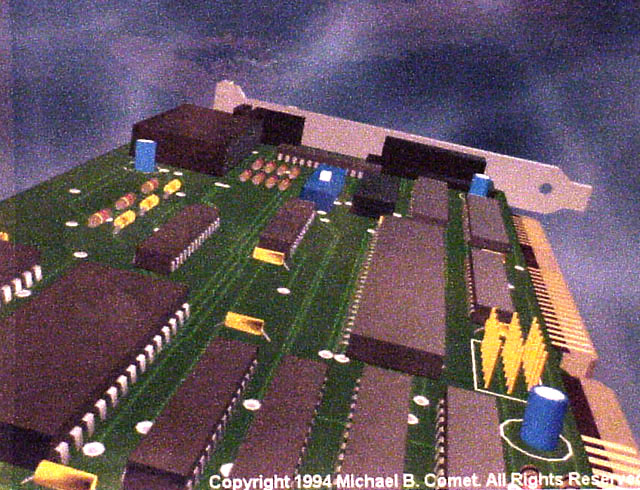 Ethernet Card:
Ethernet Card:
This was part of an animation I did for fun when I was working as a software engineer at Case Western Reserve University's network department. The card basically flew around and a laser shot out which then caused the logo for the school to appear.
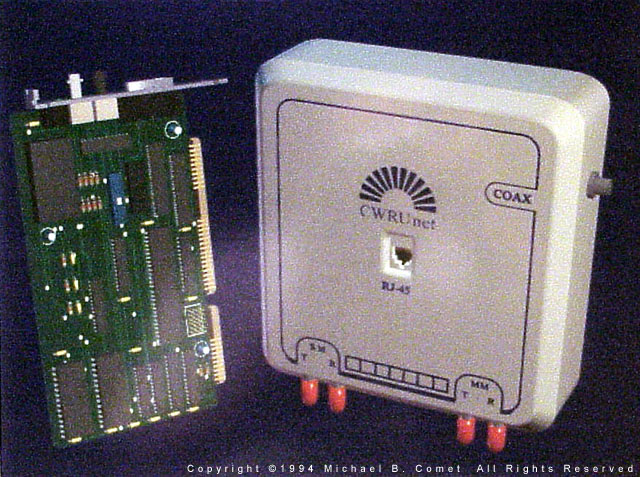 Ethernet Card and FacePlate:
Ethernet Card and FacePlate:
This is another rendering of the card, and the faceplate that was on the wall of all of the schools dorms to allow the card to be plugged in. Created with Imagine PC 3.0.
By this point my modeling of more engineered type shapes had improved significantly.
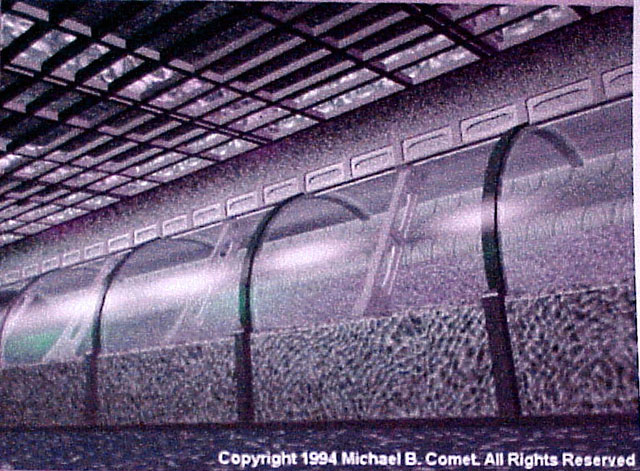 Sci-Fi Hall Start:
Sci-Fi Hall Start:
While I was working at CWRU doing network programing, I ran into some people in another department who were working to create a SciFi CDROM magazine with Director. I think it was Director 3 or 4 at that time. After talking to them, we decided I would be able to help out by creating all the artwork for the interface and such for magazine. Like the game graphics I did later, this project too was never published, but it was fun and gave me some experience with deadlines, and working with other people.
This is an initial graphics I did for a future train station type area, mostly textured with procedural textures, started around 1994.
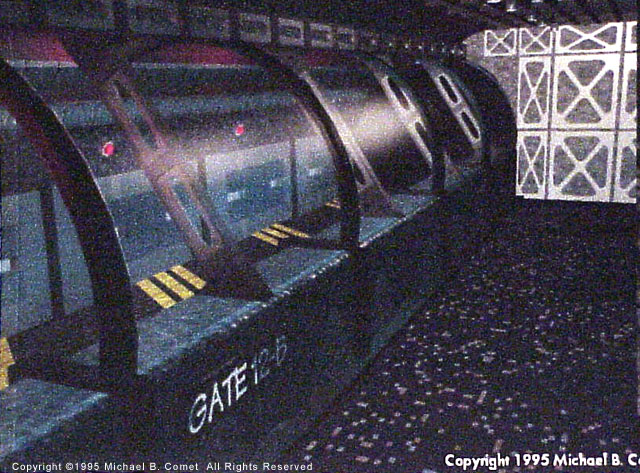 Sci-Fi Hall:
Sci-Fi Hall:
This is a more complete version of the train hall from a different angle. I never did end up modeling the train in it.
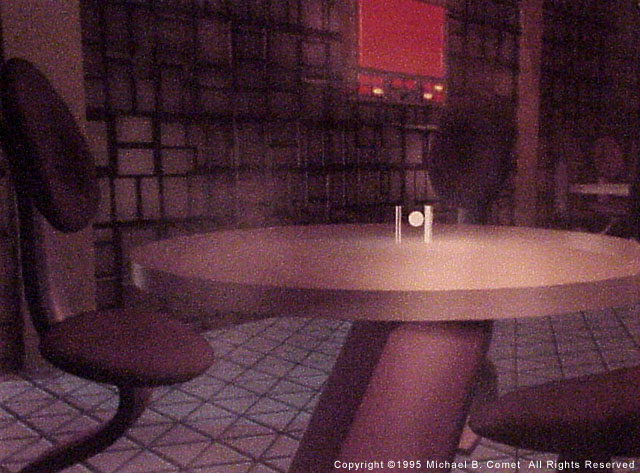 Sci-Fi Diner:
Sci-Fi Diner:
This is a closeup of a dining area I did for the SciFi CDROM magazine as well. The red screen in the background was related to an original interface I had designed, that some of the CD was supposed to use. The idea being that in these images, there would be hotspots that would take you to the interface to get to the real content of the magazine. Kind of like a "Myst" interface for the magzine.
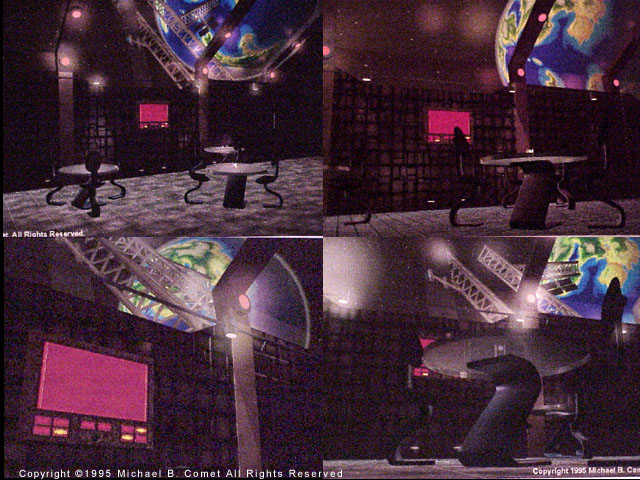 Sci-Fi Diner Shots:
Sci-Fi Diner Shots:
These are some more shots of the diner area. All of this was created with Imagine and the PC version of the software. If I recall, this was actually one of the first projects where I switched to the PC version. With the train hall being modeled originally on the Amiga, and then transferred and finished on the PC side.
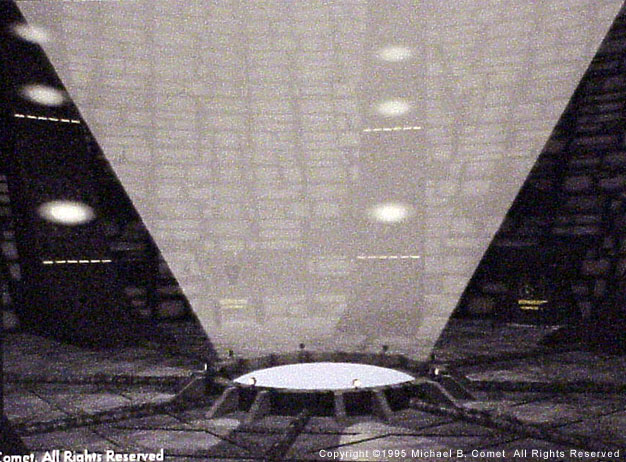 Sci-Fi Beam:
Sci-Fi Beam:
This was part of the main interface for the magazine. Text for each article was actually placed in the light beam, and was used to control what you picked.
Most of the textures relied on the Essence Textures by Steve Worley again. For example the paneling on the background was all done procedurally.
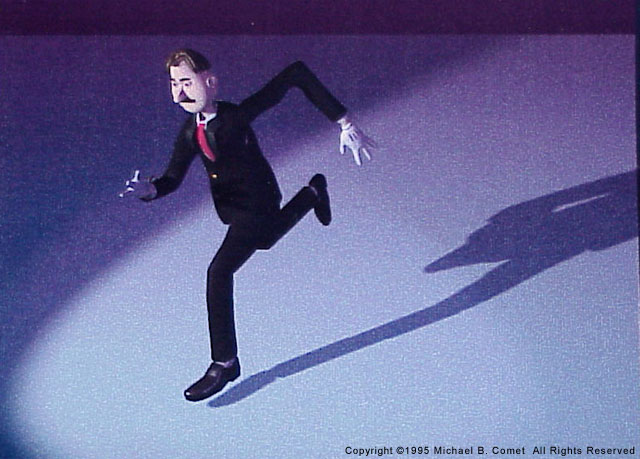 Fred:
Fred:
This was a character I modeled for Doug Kelly to do his short with. It was also used in his Lightwave 3D 5 Character Animation book. It was created mostly in Lightwave 4.0 PC. Even then, my organic modeling wasn't too perfect. They didn't have anything like Meshsmooth/Metanurbs/Subdivision Surfaces at that time. You pretty much used basic objects, and either moved and welded points by hand, or used a magnet/soft selection type tool to deform the shape. This is part of the reason he doesn't even have a mouth, except for the mustache.
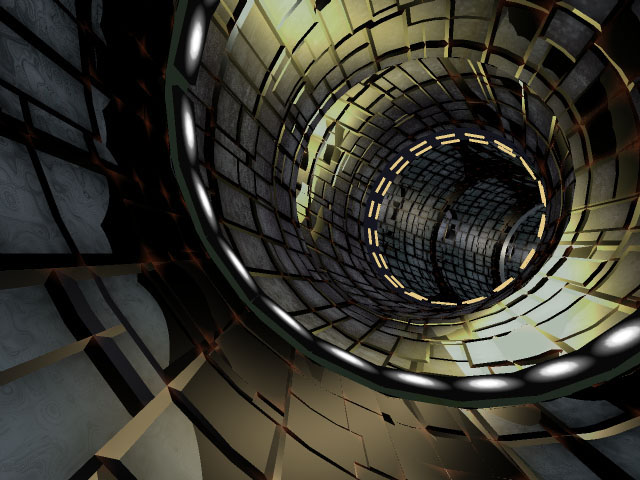 Tunnel:
Tunnel:
Almost as bad as chrome spheres, animated tunnels are another "no-no" nowadays in CG animation. This one though actually garnered interest from Blue Sky back when I applied in 1995. I guess they liked the specular mapping and lighting, though most of the textures were done with basic procedural Essence tile textures. The round lights, were fake lights of hand drawn circles of light color to simulate a lightsource mapped onto a tube. The square lights were actual cubes with self-illumination. I then had a few actual point lights inside the model for real illumination.
I actually modeled a really simple torus/donut shape. And then when I realized I couldn't texture it the way I needed around in a circle, I broke it into separate tubes all stuck together, which is the other reason I have the "light rings" there.
For the animation then, I just rotated the torus like a wheel, so that it would repeat. Then I animated the camera moving up/down and left/right but not actually through the tube, since the torus was animating. By banking the camera, and moving it, along with the donut itself rotating, it gave the illusion of flying through a tunnel, that was easily made into a looping animation.
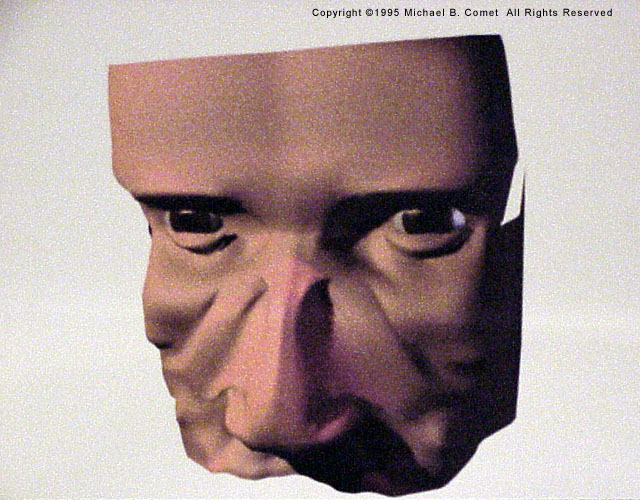 Mike Head Front:
Mike Head Front:
After doing a simple head for the Fred model above, I decided to try to figure out how to do a more realistic type model in Lightwave 4.0. I ended up finding the only way, was pretty much to take a basic model and deform it, or weld points etc... There weren't really any "cutting or slicing" type tools back then either, if I recall.
This model was basically started (and never finished) by taking primitve flat square/plane objects, and welding them together, and then deforming each individual point by hand to get the shape.
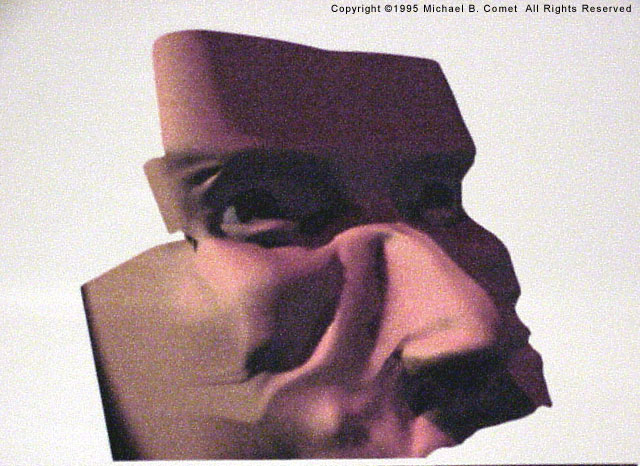 Mike Head Side:
Mike Head Side:
This shows the side angle of the same head I was working on in 1995. You can see how the side of it is just a flat plane object. There's actually quite a number of cross sections in there, but that's how I would work. I would take what I had, add another basic plane object, with 8-10 sections, and weld the parts together, and then keep moving points around in 3D to get the shape.
Definitely slow, but it worked.
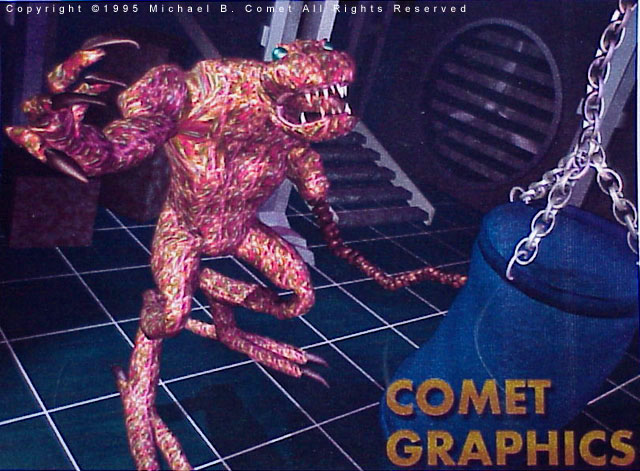 Mutant:
Mutant:
This was a character I created in 1995 with Lightwave 4.0 for a PC video game. It was a freelance job I did from home, which I never got paid for, since the game never got published. I knew that might happen, but decided to help out since it gave me a bit of experience. I actually ended up animating a number of actions that I then rendered as sprites for both this, and a cyborg character.
The game was basically a 3/4 top down fighting game, where the characters could fly around on a pad, walk, run, attack each other, lose limbs, and die. Having worked on this project, gave me a really good intro into game work, and definitely helped me get a job at Volition.
In fact, it was only shortly after doing this project, and some related personal images with the characters, that I ended up starting n the Freespace 1 game at Volition for my first fulltime 3D job.
The image here was from a cinematic animation I did of the mutant character warming up before the fight. I remember being inspired by SeaQuest DSV for making some of the dark noisy textures on the fan and wall on the back.
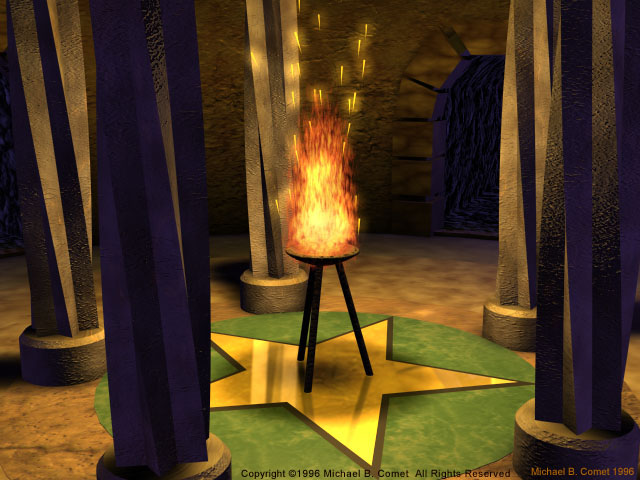 Temple (MAX):
Temple (MAX):
This is a temple image I did. I found the response I did in the first version with Imagine so strong, I recreated it in each program I learned after that, including Lightwave 4, and 3D Studio MAX r1.2. Because it's very simple, pretty much extruded and twisted shapes for the columns, and then primitive objects, it was a good way for me to learn the basics of the program.
It enabled me to play around with basic lighting and procedural texturing in each program, to see how they worked, and as such made a good "first test" type thing once I learned enough about each new image.
This is the version I did with 3D Studio MAX r1.2, after I started at Volition and was learning the software my first week or so on the job.